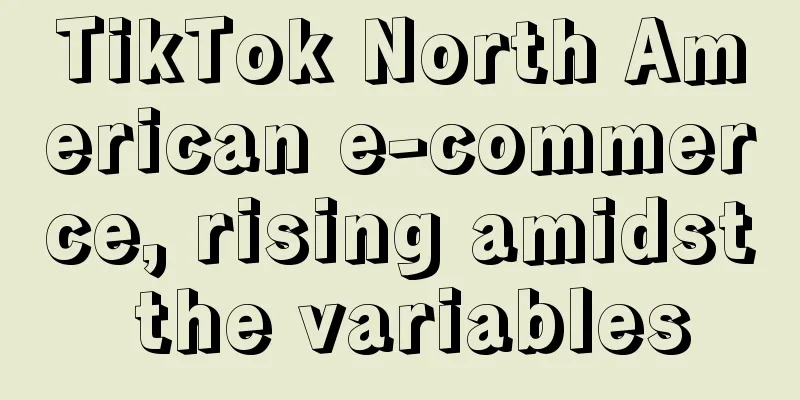How can brands get rid of the vortex of “marketing involution” from the root?

Nowadays, when talking about the workplace, market, competition, the Internet and other topics, the hot word "involution" is indispensable. Whether it is enterprises, employees, or even the entire society, they are deeply troubled by involution. Marketing, as a service to business and an inseparable behavior from competition, naturally cannot escape the clutches of involution. Especially in recent years, as the dividends of mobile Internet have gradually disappeared, leading to a downward trend in the overall market environment, reduced traffic acquisition efficiency, and increased user conversion costs, marketing involution has become a challenge that every company has to face. Marketing involution refers to the phenomenon that brands pay more costs and resources to compete for limited consumers, resulting in a continuous decline in the brand's marketing output ratio. It is a low-level, homogeneous tactical level competition. Correctly recognizing and understanding the concept of "marketing involution" can make us calmer when managing marketing projects and make more rational and objective judgments. Take the example of live streaming, which is currently favored by enterprises, to deeply understand the phenomenon and consequences caused by marketing involution: As an emerging new consumer brand, the beauty brand W would only be crushed by traditional beauty giants if it went through supermarket channel. At the same time, the expensive traffic of traditional e-commerce platforms also made the brand miserable. In order to carve out a path for itself in the fierce channel competition, Brand W decided to try a new sales model of live streaming. So they found a popular KOL Xiao Li to do live streaming and sell goods. The cooperation method is that the brand takes 20% of the sales GMV as a commission reward. The sales situation far exceeded the brand's expectations. With rich experience in cosmetics sales, as well as a large number of fans and influence, KOL Xiao Li sold nearly two million goods in just one week of cooperation. Such a terrifying sales power and sales volume even exceeded the sum of all other channels of Brand W. Another beauty brand H heard that live streaming was so effective, so it also approached KOL Xiao Li to promote its products with a half-believing and half-doubting attitude, and was willing to pay 40% commission as a reward. The sales effect was also surprisingly good, and the brand was particularly satisfied. So a battle for anchor slots began. In order to cooperate with more high-quality KOL anchors with their own traffic, brand W decided not only to give 40% commission, but also to pay an additional 200,000 per session slot fee... After several rounds of price competition over commissions and slot fees, the two brands suddenly realized that live streaming with goods is no longer as attractive as before. The brands have become lambs to be slaughtered by the anchors but are powerless to do anything: first, the anchors hold the traffic and trust endorsement, and the brands have gradually lost their voice and pricing power in front of the anchors; secondly, after paying extremely high commissions and slot fees, live streaming with goods has become a pure loss-making business. At the same time, live streaming has greatly increased the manpower input and workload of brands, resulting in more and more overtime work in the marketing department and serious employee turnover. The most fatal thing is that the entire beauty market share has not increased as it should have due to the participation of live streaming KOLs. Marketing involution has caused brands to gradually lose their voice, their profit margins have been squeezed, and their workload has increased. What’s worse is that the market piece of the pie has not become bigger as a result. This shows that marketing involution is extremely harmful to companies, employees, and the market. 1. The root cause of marketing involutionAny negative social phenomenon is the result of the combined force of multiple internal and external factors, which breaks out after breaking through a critical point; the emergence of marketing involution is also attributed to the complex and changeable domestic market environment: in recent years, the disappearance of mobile Internet dividends, the bursting of capital myths and bubbles, and the lack of revolutionary new technologies have made the survival environment of enterprises extremely severe. Faced with such an unfriendly market environment, global consumers tend to be cautious in their consumption decisions, and companies have to survive in the cracks, hoping to survive this cold winter and embrace new opportunities through uncontrolled price cuts and vicious marketing methods. Therefore, the formation of marketing involution can be roughly attributed to the following reasons: 1. Marketing and product homogeneityThe growing purchasing power of domestic consumers in recent years has led to an increasingly serious phenomenon of product homogeneity. For example, in the automobile industry, 20 years ago, people competed in functions, then in appearance, and later they felt that foreign brands were more prestigious, and then they competed in space and comfort, etc. In the end, it was found that the promotional selling points of cars of the same level and price on the market were all the same, and it was difficult for consumers to perceive obvious differences. Until the rise of new energy vehicles in recent years, the rise of new technologies such as intelligence and batteries has found new growth points in the automotive field, which has changed this embarrassing homogeneous situation. However, for most industries such as clothing, food, daily necessities, and real estate, technological change is an extremely slow process, which makes it difficult to improve the phenomenon of commodity involution. If you randomly look at the brand marketing department of any company, you will find that what they do at the marketing tactics level are relatively similar: the brand team focuses on sponsoring variety shows, offline flash mobs, shooting TVCs, celebrity endorsements, social promotion, content marketing, etc.; the marketing team engages in fierce market competition with competitors through visits to competitors, local promotions, B-end channel expansion, business negotiations, etc.; the online operations team appears to be particularly lacking in innovation, and methods such as live streaming, advertising, big promotions, sending red envelopes, giving coupons, limited-time specials, and fission growth have made consumers immune. Of course, it does not mean that the above mentioned things cannot be done, but when everyone is doing the same thing, it will lead to an infinite increase in marketing costs and a significant decrease in marketing effectiveness. This is a situation that the company itself, marketing practitioners and traffic media are unwilling to see. 2. Brand owners are anxious about trafficThe Internet is a world where traffic is king. Whoever controls the traffic has the initiative and the opportunity to make money. In the first half of the mobile Internet, any industry that is equipped with the wings of mobile Internet will usher in a wave of huge dividends and begin a period of crazy and barbaric growth. Traffic is sometimes as addictive as drugs. Companies that are used to spending money to buy traffic to maintain business development become panicked when traffic prices rise beyond their affordability. First, the expensive traffic prices make companies reluctant to buy or become extremely cautious; second, the accuracy of the purchased traffic cannot be guaranteed, resulting in the gradual ineffectiveness of the usual growth operation methods and even more difficulty in converting results. A long time ago, I heard an elder tell me a very interesting truth: "People who are used to making money easily find it difficult to make money steadily." This is now very suitable for companies that have benefited from traffic dividends. In the past few years, it was too easy to obtain traffic, which made it difficult to calm down and do refined traffic management, and eventually fell into the vortex of traffic anxiety. 3. Consumers’ discernment improvesThe current situation where corporate marketing results are unsatisfactory, from the root cause, the responsibility still lies with the companies themselves. Various false propaganda and operational routines that skirt the rules have made consumers miserable. There are even popular sketches on the Internet that use Internet marketing routines as the plot. Such a ridiculous phenomenon, on the one hand, shows that consumers are rather disgusted with the merchants' routine marketing, and on the other hand, it shows that consumers have a stronger ability to distinguish true from false marketing. In the game between merchants' routines and consumer purchases, consumers are gradually gaining the upper hand and initiative. Take Double Eleven for example. Although this year's Double Eleven GMV continued to grow, consumers have long been indifferent to the sales of 540 billion yuan. The Double Eleven promotion is no longer a hot topic among the public. The real-time GMV broadcast, which was a big show on Double Eleven in the past, has also been quietly cancelled by Alibaba. 4. Capital valuation bubbleIn recent years, we have witnessed too many new brands going public quickly and becoming rich overnight, which has led the public to mistakenly believe that the standard of a successful brand depends on its financing ability, whether it is recognized by capital, whether it can go public, etc., while the product technology innovation, brand asset building, user word-of-mouth management, etc. that truly create long-term value have been weakened in the battle of enterprise development. The domestic consumption potential is huge, and the supply chain, logistics and other infrastructure are relatively complete, resulting in many brands constantly competing for this limited sweet cake, and internal circulation has become inevitable. But we can see from the delisting of Luckin Coffee that internal circulation will cause the brand to fall into an extremely irrational carnival, constantly creating and amplifying expectations, violating the original intention and values, and ultimately leading to irreversible painful lessons. 2. The manifestation of marketing involutionIf an industry is caught in a vortex of marketing involution, there will usually be some or more vicious competition phenomena at the tactical level, mainly including product innovation, marketing tactics, competition for consumer attention, traffic acquisition, sales channels and other involutions. 1. Product innovation involution The essence of product innovation involution is the lack of corporate innovation or technical capabilities. For example, when a company makes a hit product, other competing brands will follow suit and soon the entire market will be filled with similar products. Traditional manufacturing and service industries are the hardest hit in this regard. 2. Marketing tactics involution The internal circulation of marketing tactics is one of the most important reasons for the reduction in corporate marketing efficiency and the increase in costs. As mentioned earlier, when we think of advertising marketing, we think of shooting TVCs, making posters, cross-border operations, flash mobs, developing H5, etc. When we think of conversion operations, we think of discounts and price cuts, group bargaining, MGM bringing in new customers, daily check-ins, etc. First, the unchanging marketing routine will make users immune and indifferent, and their interest and motivation to participate will naturally decrease; secondly, the benefits advertised by many merchants and what users actually get are as different as the buyer's show and the seller's show, which leads to a continuous decrease in users' trust and tolerance for merchants. 3. Traffic involution Traffic involution has become a fact recognized by everyone. Without traffic, there is no business to speak of. However, the landscape of major Internet fields has become stable, and traffic is controlled by a few super platforms and media. If you want to get traffic, you either have to exchange it with something valuable or spend money to buy it. Even the market valuation of most Internet companies depends on their traffic data such as number of users, DAU, MAU, etc., so the competition for traffic is destined to be a never-ending war. 4. Attention involution This can be said to be the culprit for the prevalence of vulgar advertising. When normal content and information can no longer attract consumers' attention and discussion, many companies have to choose to play by the rules to attract attention. Although the bosses are also well aware of the damage that vulgar advertising can cause to the brand image and some potential risks, they can only choose to compromise in the face of a survival crisis. Attention involution is essentially a kind of mental traffic involution. Compared with the traffic that can be counted by data, mental traffic is an invisible and intangible long-term traffic, but the value it brings to the enterprise is indeed beyond the reach of data traffic. 5. Sales channel involution The involution of sales channels has always existed. Before the emergence of e-commerce, whoever could handle offline channels and distributors meant that they controlled the market and sales; in the traditional e-commerce era, whoever could play through the rules of the e-commerce platform could get more sales. Nowadays, the most popular ones are the new retail that combines online and offline (such as Hema Fresh, Miss Fresh, Luckin Coffee, etc.), as well as social e-commerce (mini programs, live streaming, KOL recommendation, private domain traffic operation, etc.). Although the competition for channels has always been fierce, fortunately, channels are also constantly developing and changing with technology and market environment. As long as companies dare to step out of their comfort zones and embrace new channels and new technologies, they can make themselves invincible. If the industry you are in has already experienced the above-mentioned involutionary phenomenon, you must actively seek change and find new opportunities and growth points in marketing. Pull yourself out of the vortex of marketing involution, and perhaps you will see a broader sky. 3. Get rid of marketing involutionIn recent years, driven by capital, we have seen too many companies quickly go public and the founding team become rich overnight, while those companies that patiently develop good products, serve users, and create brand value are often ignored by the public. Therefore, we do not know that the development of marketing involution to such a serious extent is caused by changes in the market environment and bottlenecks in technological innovation, and the continuous ambition and expectations of enterprises are also the culprits of involution. 1. Operate rationally and avoid marketing shortsightednessEveryone in the industry knows that the essence of marketing is to meet user needs. However, there are not many marketers who can truly understand user needs, perform user operations, and create value for users. Meeting user needs has become an empty slogan, and when it comes to the actual implementation process, they always cannot resist the temptation and commit marketing myopia. In the era of hot capital, the phenomenon of burning money to seize the market and the winner takes all is endless. However, after the capital market has calmed down in recent years, if you still adopt the model of violently burning money, you will only become a stepping stone for others, because there is no lowest price in the price war, only lower prices, and it is harder than climbing to the sky to become the final winner. Whether it is financing or market expansion, you need to calm down and think twice before acting. 2. Make good products and bring their own communication effectsCommodities are the best self-media for brand communication, and consumer word-of-mouth is the best form of communication; creating a hit product with its own communication requires several important elements: the product solves certain needs of consumers, conforms to popular aesthetics and culture, and highlights a certain identity of consumers to form social currency. Of course, social media topic planning is also an indispensable part. After all, in an age of information overload, even the best products will not be well known if they are not well-known. For example, Dyson hair dryers, lululemon yoga clothes, Pop Mart blind boxes, etc. are all typical products with their own communication characteristics. They save companies huge communication costs and are sought after by consumers for a long time. 3. Keep up with the times and embrace emerging channelsTraditional supermarket shelves are expensive, and competition for traffic on e-commerce platforms such as Tmall and JD.com is fierce. If a company still clings to these sales channels, it will be crushed by the high customer acquisition costs. Smart companies should actively embrace changes in channels and try new channels to bring more growth points, because the emergence of each new channel will usher in a wave of early traffic dividends, and timely seizing the dividend period can bring twice the result with half the effort. For example, self-built private channels, early live streaming, strict crowdfunding/necessary malls and other innovative channels are all worth trying for companies. 4. Marketing innovation, breaking the conventional routineAs mentioned earlier, the homogeneity of marketing tactics is also an important reason for internal circulation, so constantly repeating old marketing methods will only make consumers bored or attract a wave of fixed wool parties. Although the marketing methods of most companies are very similar, there are still some excellent hot-selling cases every year. They help brands or industries explore more new marketing possibilities, such as the disco live broadcast of Higo Beauty Girls, NetEase Cloud Music's Internet Depression Cloud/music review heartfelt marketing/test screen-sweeping H5, Lao Xiangji's earthy strategy conference, and DingTalk's online begging song, which are all innovative marketing cases worthy of recognition. In short, marketing involution is an inevitable product of changes in the market environment and market competition. What marketers can do is to dare to break the thinking and actively innovate, and understand that user value creation and brand value management are the foundation of marketing. A marketer who wants to keep up with the development of the times must not only understand budget, traffic, sales, resources, hot items, and screen-sweeping, but also talk about products, operations, profits, experience, services, and business! Author: Lao Pao WeChat public account: Lao Pao OG |
>>: Why are car manufacturers “in love” with video platforms?
Recommend
10,000-word analysis | A complete closed loop from brand breaking through the circle to harvesting on Douyin
In this article, the author explains in detail the...
What is the Amazon Logistics New Product Warehouse Promotion Program? What does it include?
Amazon Logistics' New Product Warehouse Promot...
In the years of game community operation, I summarized these
Editor's note: "Nowadays, more and more p...
How is it for a novice seller to enter Amazon? How much money can a novice seller usually make on Amazon?
For new sellers, they are often curious and confus...
What is the Amazon Account Status Protection Program? Details
Amazon sellers can use the newly upgraded "Ac...
Official accounts suddenly upgraded their “publish” function. Has WeChat come to its senses?
Recently, the official account was updated again, ...
"Rose Story" and "Moyuyunjian" became popular during the 618 period. How can brands take advantage of the big drama IP and big promotion IP?
Why did the 618 shopping festival see a combinatio...
Cat memes dominate the charts on three platforms, hitting three key elements of a hit
This article deeply analyzes the phenomenon of cat...
Ozon launches new payment method Lianlian cross-border wallet
Ozon announced the launch of a new payment method ...
When does Amazon have discounts? What is the best deal on Amazon China?
Understanding Amazon's discount timing can hel...
Beating Xiao Yangge! This Douyin traffic dark horse is a bit crazy!
The huge cultural differences between the north an...
Can a self-employed person register on Amazon? Can a self-employed person enter Amazon?
Many merchants who open stores on Amazon hire a co...
In the crowded ice and snow track, these brands use "lists" to break the circle in Douyin e-commerce
The season for playing in the snow is here again. ...
The single-game GMV beats Brother Yang. What are the killer features of the dark horse anchor Mi Daodao?
As more and more people start to join the live bro...
ByteDance has created a new Douyin search app, but is it actually a Xiaohongshu?
In the competition among Internet giants, ByteDanc...









